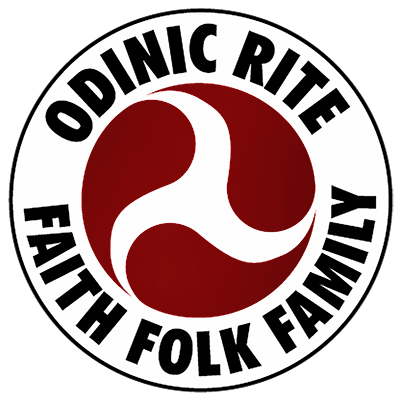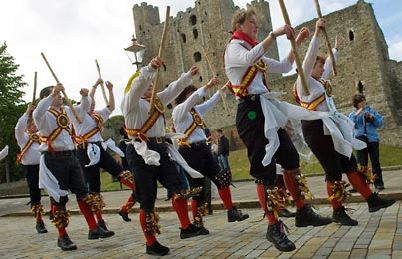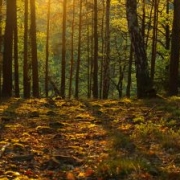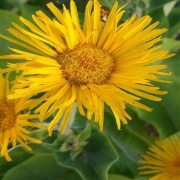Odinic Ritual: The meaning and need for Dance
During the Fylfot Hearth’s Yule celebrations last year, I was talking to Hengest OR about the Morris Dance I had been learning over the past few months, and about how many of those who dance it today do not see any ritual significance to it, they merely enjoy it as exercise and an excuse for quaffing copious amounts of ale. And as with most modern folk dancers/singers, they are not Folkish, and therefore see no reason to keep these traditions for our people only – it is just a spare-time hobby for all and sundry. This angers us, and coupled with the fact that the true meaning of these dances is becoming evermore clouded, Hengest said that we must start to reclaim them for ourselves, for our Folk and for Odinism, which is what they were originally about. This got me thinking and I became resolved to do something – I had the opportunity, I was learning the old dances, and was in a position where I could begin to work them into my own ritual. The first such ritual of mine which included a dance was my Hama Inauguration ritual, and it went so well that I decided the potential was there to work with the idea in more detail.
During this year’s Odinic Rite Folk Camp, I demonstrated a ritual dance, which was composed from Morris dancing steps of the Cotswold tradition. I originally devised this dance for my Hama Inaugural Blot earlier this year. The reason I decided to perform this dance at the Summer Folk Camp was because I wanted to show those who had not considered it before, that ritual dance has great potential for Odinism in the Modern World. We can observe that every indigenous people has, or has had, dances of a kind that have a clear ritual significance, perhaps the most commonly known and universally practised dance being the raindance. Our Indo-European Folk would of course have had such dances, many of which have been lost thanks to the unforgivable work of Christianity; yet we still see remnants of these rituals in the folk dancing and other practices continued to this day, though the meaning is often overlooked or forgotten. There are many examples of dances containing ritual significance within Europe, but since I am English and have composed this dance using traditional English Morris dancing steps, it is only this particular style that I will be discussing during the article; other Europeans should be encouraged to research the folk dances in their own region/country, and reclaim them under the Odinic banner.
Deerskull Hama’s Inuagural dance
The dance is circular and in it’s original performance took place around the Sacred Fire of the Blot. The dance begins with myself standing North of the fire, adopting the Algiz stance, handkerchiefs held aloft. I hail the High Ones, and then move around the fire in a circle; this could be seen as ‘opening the circle’. When I have returned to the North position, I perform a ‘galley’, and move to each cardinal point, performing such a ‘galley’. When I have returned to the North position, I perform what is called a ‘beetle-crusher’, which is a kind of step and jump that takes me in towards to centre of the circle and the fire. I repeat this at each cardinal point. When I return to North, I perform a ‘double side-step’, which again brings me towards the centre and the fire, and is again repeated at each cardinal point. When I reach North, I dance around the circle again using the standard Morris stepping, and this could be seen as ‘closing the circle’. When I reach the North position, I jump, and landing in the Algiz stance shout ‘Sig Wunjo Wunjo Sig’, and the dance is concluded. At approximately three minutes in length, it is not long (though long enough to leave an unfit dancer like me gasping for air if performed with vigour), and there is much room for potential development/additions etc, such as in the incorporation of music or drumming, which will be covered later on.
The response to this dance at the Folk Camp was very positive, and there were a few interesting comments made, for example, one said the circle and the movement in and out at each cardinal point created a Sunwheel, casting it on the Earth. Others said the handkerchiefs thrust in towards the fire at each point was like bestowing positive, vigorous energy into the sacred space/circle.
The purpose of and need for ritual dance
Ritual dancing would be practised for any number of reasons. Since I am no expert on our Folk Way and have only been walking this path for a very short while, I can only point to a couple of occasions where a ritual dance would be of use. For example, I composed and performed the ritual dance of my Hama Inauguration simply to honour the Gods and the Wights and spirits of the forest, and also to physically take the first step using dance in Blotar; the Hama was a personal landmark and so incorporating dance into it seemed appropriate. The other reasons a folk would develop and perform ritual dances could be for to celebrate the turning of the seasons, e.g. a Midsummer Dance and a Midwinter Dance, each dance displaying and celebrating the particular characteristics of the season and it’s effect on the Land and People. Another use of ritual dance is for shamanic/seidr purposes, for example to induce a trance state or to perform a healing, perhaps the person to be healed being at the centre of the dancers whilst they conduct healing energies into the sick person. The possibilities and potential for this are endless, and can be tailored to whatever need our Folk have. The fact is, just like with the rest of Odinism, we have lost so much knowledge and wisdom, and though we are aware that there is so much more going on ‘behind the scenes’ in the realm of metaphysics, it is a an enormous and endless task in trying to re-forge and relearn our understanding of the cosmos.
As Heimgest DCG pointed out to me, regarding ritual dance: “These are important aspects of our way, as yet fairly underdeveloped but like most things, they cannot be falsely rushed and need to develop organically.” Clearly a ritual dance, if it is to be used as an Odinic vehicle, needs to be approached with the right mindset and with the correct intentions. Composing the dance itself should even warrant a ritual approach – it should not simply be a few steps/manoeuvres stapled together any which way or other over lunch or coffee, but it should be developed carefully, and each action should have a meaning or significance in accordance with the intent of the dance. My approach to the dance you have seen may not have been as I would now have wanted it – it was the first attempt, and I simply worked with what I had, on my own, to produce something that could have some significance.
There is much to be done in this area, it is an exciting prospect and one that will require a lot of energy and dedication put into it. It will not be rushed, and it may take some time before this project comes to fruition, but as Heimgest pointed out, this is essential and we should not simply produce a dance to ‘tick another box’.
If anyone else is interested in this project, or knows folk dances and believes they have identified Odinic significance within them, please contact either myself or the Court of Gothar, and we can work on this area together, hopefully to develop suitable dances one day to be used in Blotar or other spiritual practice.
Hail the Folk Ways
Hail the High Ones
Hail the Odinic Rite.





Leave a Reply
Want to join the discussion?Feel free to contribute!